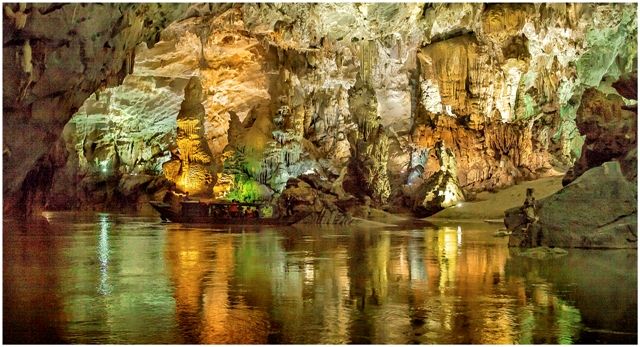Cycling Phong Nha cave and Son Doong the world biggest cave
Embarking on a cycling holiday from Hanoi to Phong Nha Cave and Son Doong Cave is an adventure that combines the thrill of long-distance cycling with the wonder of exploring some of Vietnam’s most spectacular natural landscapes. This journey offers an unforgettable experience, blending physical challenge, cultural immersion, and the awe-inspiring beauty of the world’s largest cave systems.

Starting Point: Hanoi
Hanoi, the vibrant capital of Vietnam, serves as the perfect starting point for this epic journey. Known for its bustling streets, ancient temples, and rich cultural heritage, Hanoi is a city that captivates the senses. Before setting off on your cycling adventure, take the time to explore some of the city’s iconic landmarks, such as the Hoan Kiem Lake, the Old Quarter, and the Temple of Literature.
The Route
The journey from Hanoi to Phong Nha spans approximately 500 kilometers, traversing a diverse range of landscapes, from bustling urban areas to tranquil rural countryside. The route can be divided into several stages, each offering its own unique experiences and challenges.
Stage 1: Hanoi to Ninh Binh (90 kilometers)
The first leg of the journey takes you from Hanoi to Ninh Binh, often referred to as “Halong Bay on land” due to its stunning karst landscape. Cycling out of Hanoi, you’ll quickly find yourself surrounded by lush green fields and traditional villages. Ninh Binh is famous for its picturesque landscapes, including the Trang An Scenic Landscape Complex, a UNESCO World Heritage site. Here, you can take a boat ride through the complex network of rivers and caves, offering a welcome respite from your cycling efforts.
Stage 2: Ninh Binh to Thanh Hoa (60 kilometers)
From Ninh Binh, the route continues to Thanh Hoa, a province known for its beautiful beaches and historical sites. The ride is relatively flat, making it a comfortable stretch for most cyclists. In Thanh Hoa, you can visit the Ho Citadel, another UNESCO World Heritage site, which dates back to the 14th century. The citadel’s impressive stone walls and gates provide a fascinating glimpse into Vietnam’s past.
Stage 3: Thanh Hoa to Vinh (140 kilometers)
This stage is the longest and most challenging part of the journey. The route takes you through rural landscapes and small towns, offering a glimpse into everyday life in Vietnam. Vinh, the capital of Nghe An Province, is a bustling city with a rich history. It is also the birthplace of Ho Chi Minh, and you can visit the Ho Chi Minh Square and the Kim Lien Village to learn more about the country’s revered leader.
Stage 4: Vinh to Dong Hoi (190 kilometers)
The route from Vinh to Dong Hoi runs along the scenic coastal road, offering breathtaking views of the sea and the opportunity to stop at beautiful beaches. Dong Hoi, the capital of Quang Binh Province, is the gateway to the Phong Nha-Ke Bang National Park. Here, you can relax and recharge before heading into the national park to explore its famous caves.
Phong Nha-Ke Bang National Park
Phong Nha-Ke Bang National Park is a UNESCO World Heritage site known for its remarkable karst landscapes and extensive cave systems. The park is home to some of the world’s most spectacular caves, including Phong Nha Cave and the iconic Son Doong Cave, the largest cave in the world.
Phong Nha Cave
Phong Nha Cave is one of the most famous and accessible caves in the national park. The cave is known for its impressive stalactites and stalagmites, and its underground river. A boat tour takes you through the cave’s vast chambers, where you can marvel at the natural rock formations and the pristine beauty of the cave. The cave is well-lit, making it easy to appreciate the intricate details of the stalactites and stalagmites.

Son Doong Cave
Son Doong Cave, discovered in 2009, is the largest cave in the world. The cave is so vast that it has its own ecosystem, including a river, jungle, and unique climate. A visit to Son Doong Cave is a once-in-a-lifetime experience, but it requires advance planning and preparation. The tour is physically demanding and involves trekking, climbing, and camping inside the cave. Only a limited number of visitors are allowed each year to preserve the cave’s pristine condition.
Exploring Son Doong Cave is an adventure like no other. The journey into the cave includes passing through the “Hand of Dog,” a massive stalagmite shaped like a canine paw, and crossing the “Great Wall of Vietnam,” a towering wall of rock. Inside the cave, you’ll find a surreal landscape of giant stalagmites, underground rivers, and lush vegetation. The sense of scale and grandeur is truly awe-inspiring.
Accommodation and Logistics
Throughout the cycling journey, there are various accommodation options ranging
 Next Post
Next Post